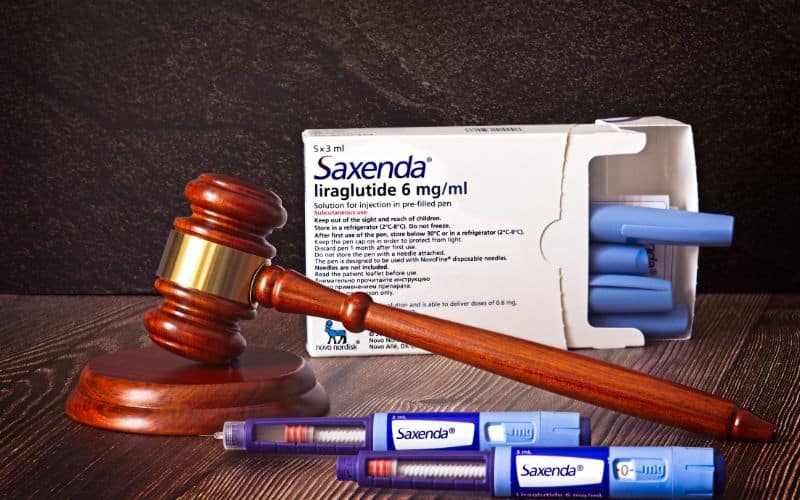Saxenda and Ozempic are two prescription medications that have been approved by the FDA for weight loss. Saxenda is a medication that is used to treat obesity, while Ozempic is used to treat type 2 diabetes. Despite their different intended uses, both medications have been found to be effective in helping people lose weight.
Saxenda and Ozempic work by mimicking the effects of a hormone called glucagon-like peptide-1 (GLP-1) in the body. GLP-1 is a hormone that is naturally produced in the body and is responsible for regulating appetite and glucose metabolism. By mimicking the effects of GLP-1, Saxenda and Ozempic can help to reduce appetite, increase feelings of fullness, and improve glucose metabolism, all of which can lead to weight loss.
While both medications have been found to be effective in helping people lose weight, they do have some differences. For example, Saxenda is injected once a day, while Ozempic is injected once a week. Additionally, Saxenda has been found to be more effective in helping people lose weight, but it also has more side effects than Ozempic. Ultimately, the choice between Saxenda and Ozempic will depend on a variety of factors, including the individual's medical history, weight loss goals, and preferences.
Contents
Overview of Saxenda

Saxenda is a prescription medication used for weight loss in adults who are obese or overweight. It contains the active ingredient liraglutide, a glucagon-like peptide-1 (GLP-1) receptor agonist. Saxenda works by mimicking the effects of GLP-1, a naturally occurring hormone in the body that regulates appetite and glucose metabolism.
Saxenda is an injectable medication that is self-administered once a day. The dose is gradually increased over several weeks to the recommended maintenance dose of 3 mg per day. Saxenda should be used in combination with a reduced-calorie diet and increased physical activity.
According to clinical studies, Saxenda has been shown to be effective in promoting weight loss. In a 56-week study, patients who took Saxenda lost an average of 8.4% of their initial body weight, compared to 2.8% for patients who received a placebo. Saxenda has also been shown to improve other health markers, such as blood pressure and cholesterol levels.
Like all medications, Saxenda may cause side effects. The most common side effects include nausea, diarrhea, constipation, vomiting, and low blood sugar (hypoglycemia). In rare cases, Saxenda may also cause pancreatitis, a potentially life-threatening inflammation of the pancreas.
Saxenda is available only by prescription and should be used under the supervision of a healthcare professional. It is not recommended for use in individuals with a personal or family history of medullary thyroid carcinoma or multiple endocrine neoplasia syndrome type 2, as Saxenda may increase the risk of these conditions.
Overview of Ozempic
Ozempic is a prescription injection medication primarily used to treat type 2 diabetes. It is also approved for use in adults with a BMI of 30 or greater or in adults with a BMI of 27 or greater who have at least one weight-related medical condition. The medication is a glucagon-like peptide-1 (GLP-1) receptor agonist that works by mimicking the effects of GLP-1, a naturally occurring hormone that stimulates insulin secretion and lowers glucagon secretion from the liver.
Ozempic is given as a subcutaneous injection under the skin once a week. It is available in pre-filled pens in doses of 0.25 mg, 0.5 mg, 1 mg, and 1.5 mg. The medication is intended to be used alongside diet and exercise to improve glycemic control in adults with type 2 diabetes.
Clinical studies have shown that Ozempic can help lower blood sugar levels, reduce body weight, and lower the risk of cardiovascular events in people with type 2 diabetes. The medication has also been shown to be safe and effective for children 12 years of age and older with certain BMIs.
Like all medications, Ozempic can cause side effects. The most common side effects include nausea, vomiting, and changes in stool pattern. These side effects usually go away on their own after a few days or weeks. In rare cases, Ozempic can cause more serious side effects such as pancreatitis or kidney problems. It is important to talk to a healthcare provider about the risks and benefits of taking Ozempic before starting the medication.
Mechanism of Action: Saxenda
Saxenda is a prescription injection medication that is used for weight loss in adults who are overweight or obese. The medication contains the active ingredient liraglutide, which is a glucagon-like peptide-1 (GLP-1) receptor agonist.
GLP-1 is a hormone that is naturally produced by the body in response to food intake. It plays a key role in regulating appetite, insulin secretion, and glucose metabolism. Saxenda works by activating GLP-1 receptors in the body, which helps to reduce appetite and increase feelings of fullness.
In addition to reducing appetite, Saxenda can also help to improve blood sugar control and reduce the risk of type 2 diabetes. The medication is administered as a subcutaneous injection once a day, and the dose is gradually increased over several weeks to minimize side effects.
Common side effects of Saxenda include nausea, vomiting, diarrhea, constipation, and stomach pain. These side effects are usually mild and go away on their own within a few days or weeks. In rare cases, Saxenda can cause more serious side effects such as pancreatitis, gallbladder disease, and kidney problems.
It is important to note that Saxenda is not a magic pill for weight loss. It should be used in combination with a healthy diet and regular exercise to achieve and maintain weight loss. Patients who do not achieve a 5% weight loss after 12 weeks of treatment should discontinue Saxenda, as it is unlikely to be effective for them.
Mechanism of Action: Ozempic

Ozempic is a medication that is used for weight loss in individuals who are overweight or obese. The medication works by activating GLP-1 receptors in the body. GLP-1 is a hormone that is released in response to food intake, and it plays a key role in regulating appetite, insulin secretion, and glucose metabolism.
When Ozempic is injected into the body, it binds to GLP-1 receptors and activates them. This leads to a decrease in appetite and an increase in feelings of fullness. Additionally, Ozempic slows down the rate at which food leaves the stomach, which can further help to reduce appetite.
Ozempic also helps to regulate blood sugar levels by increasing insulin secretion and decreasing glucagon secretion. This can be particularly beneficial for individuals with type 2 diabetes who may struggle with high blood sugar levels.
Overall, Ozempic works by targeting multiple pathways in the body that are involved in regulating appetite and blood sugar levels. By doing so, it can help individuals to achieve and maintain weight loss and improve their overall health.
Comparative Efficacy for Weight Loss
Saxenda and Ozempic are two prescription medications that have been approved by the FDA for weight loss. Both medications have been shown to be effective in reducing body weight in adults with obesity or overweight, but they work in slightly different ways.
Saxenda is a GLP-1 receptor agonist that mimics the effects of a hormone called glucagon-like peptide-1 (GLP-1), which is naturally produced by the body. It works by slowing down the movement of food through the stomach, which helps to reduce appetite and increase feelings of fullness. Saxenda is usually injected once a day, and the dose is gradually increased over several weeks.
Ozempic is also a GLP-1 receptor agonist, but it is primarily used to treat type 2 diabetes. However, it has also been shown to be effective in promoting weight loss in people with obesity or overweight. Like Saxenda, it works by slowing down the movement of food through the stomach and increasing feelings of fullness. Ozempic is usually injected once a week.
In clinical trials, both Saxenda and Ozempic have been shown to be effective in promoting weight loss. In a 68-week study of Saxenda, participants lost an average of 14.9% of their body weight, compared to 2.4% for those taking a placebo. In a 52-week study of Ozempic, participants lost an average of 13.8% to 11.2% of their body weight, compared to 7.8% for those taking a placebo.
It is important to note that weight loss results can vary depending on the individual and other factors such as diet and exercise. Additionally, both medications can have side effects, such as nausea, vomiting, and changes in stool pattern. It is important to discuss the potential benefits and risks of these medications with a healthcare provider before starting treatment.
Overall, both Saxenda and Ozempic have been shown to be effective in promoting weight loss in adults with obesity or overweight. The choice between the two medications may depend on factors such as frequency of dosing, individual response to treatment, and other medical conditions.
Side Effects of Saxenda
Saxenda is a medication that is prescribed to help with weight loss. However, like any medication, it can have side effects. It is important to be aware of these side effects before starting Saxenda.
The most common side effects of Saxenda include nausea, vomiting, and changes in stool pattern. These side effects are usually mild and go away on their own. However, if they persist or become severe, it is important to talk to your healthcare provider.
In rare cases, Saxenda can cause more serious side effects. These can include pancreatitis, gallbladder disease, and kidney problems. If you experience severe abdominal pain, yellowing of the skin or eyes, or signs of kidney problems such as swelling in the legs or feet, it is important to seek medical attention immediately.
It is also important to note that Saxenda can interact with other medications. For example, it can increase the risk of low blood sugar when taken with certain diabetes medications. It is important to talk to your healthcare provider about all medications you are taking before starting Saxenda.
Overall, Saxenda can be an effective medication for weight loss, but it is important to be aware of the potential side effects and to talk to your healthcare provider about any concerns you may have.
Side Effects of Ozempic
Ozempic is a medication used for the treatment of type 2 diabetes and weight loss. It is a glucagon-like peptide-1 (GLP-1) receptor agonist that helps control blood sugar levels by stimulating insulin secretion and reducing glucagon secretion from the liver. However, like any medication, Ozempic may cause side effects in some people.
Some of the most common side effects of Ozempic include nausea, vomiting, and changes in stool pattern. These side effects may occur during the first few weeks of treatment and usually go away on their own. However, if they persist or become severe, you should contact your healthcare provider.
In rare cases, Ozempic may cause more serious side effects such as pancreatitis, kidney problems, or allergic reactions. If you experience severe abdominal pain, persistent nausea or vomiting, or signs of an allergic reaction such as rash, itching, or swelling, seek medical attention immediately.
It is important to note that Ozempic may also increase the risk of low blood sugar (hypoglycemia), especially if taken with certain diabetes medications such as sulfonylureas or insulin. Symptoms of low blood sugar may include headache, dizziness, sweating, confusion, and shakiness. If you experience any of these symptoms, you should check your blood sugar level and consume a source of glucose such as fruit juice or candy.
Overall, Ozempic is a safe and effective medication for the treatment of type 2 diabetes and weight loss. However, it is important to be aware of the potential side effects and to contact your healthcare provider if you experience any symptoms that concern you.
Cost Analysis: Saxenda vs Ozempic
When it comes to weight loss medications, cost is an important factor to consider. Both Saxenda and Ozempic are brand-name medications and are not available as generics, which can make them expensive.
According to GoodRx, the average retail price for a 4-week supply of Saxenda is around $1,300, while a 4-week supply of Ozempic costs around $1,100. However, the actual cost may vary depending on factors such as insurance coverage, pharmacy location, and dosage.
It's worth noting that both medications may require a higher dosage for weight loss than they do for their respective FDA-approved uses (obesity for Saxenda and type 2 diabetes for Ozempic), which can further increase the cost.
Fortunately, both manufacturers offer savings programs that can help reduce the out-of-pocket cost for eligible patients. Saxenda offers a savings card that can reduce the cost to as little as $25 per prescription, while Ozempic offers a savings card that can reduce the cost to as little as $25 for a 1-month supply.
It's important to talk to your healthcare provider and insurance company to determine the most cost-effective option for you.
Patient Reviews and Experiences
When it comes to weight loss, many people turn to medication to help them achieve their goals. Saxenda and Ozempic are two popular options, but how do they stack up in terms of patient experiences?
According toDrugs.com, Saxenda has an average rating of 7.5 out of 10 from a total of 1,427 ratings. Of those reviewers, 66% reported a positive effect while 15% reported a negative effect. One reviewer described Saxenda as "a miracle drug" that helped them lose 70 pounds in six months, while another reported experiencing severe nausea and vomiting. Other common side effects include constipation, diarrhea, and headache.
Ozempic, on the other hand, has fewer reviews on Drugs.com, with a total of 1,005. Its average rating is also 7.5 out of 10, with 66% of reviewers reporting a positive effect and 14% reporting a negative effect. One reviewer reported losing 25 pounds in four months, while another noted that they experienced no weight loss but did see an improvement in their blood sugar levels. Common side effects of Ozempic include nausea, diarrhea, and constipation.
It's important to note that not everyone will experience the same side effects or see the same results when taking these medications. As with any medication, it's important to talk to your doctor about the potential risks and benefits before starting treatment. Additionally, it's important to follow the prescribed dosage and to make lifestyle changes, such as eating a healthy diet and exercising regularly, in order to see the best results.
Medical Expert Opinions

When it comes to Saxenda vs Ozempic for weight loss, medical experts have varying opinions. Some experts believe that Saxenda is a more effective weight loss medication than Ozempic. Saxenda works by mimicking a hormone called glucagon-like peptide-1 (GLP-1), which suppresses appetite and helps regulate blood sugar levels. According to Dr. Caroline Apovian, a professor of medicine at Boston University School of Medicine, Saxenda is "the most effective weight loss medication on the market today."
On the other hand, some experts believe that Ozempic is a better option for weight loss because it has fewer side effects than Saxenda. Ozempic works by mimicking a hormone called glucagon-like peptide-1 (GLP-1), which stimulates insulin secretion and helps regulate blood sugar levels. According to Dr. Osama Hamdy, medical director of the Obesity Clinical Program at Joslin Diabetes Center, Ozempic "has a better side effect profile and is more tolerable than Saxenda."
Ultimately, the choice between Saxenda and Ozempic for weight loss should be made in consultation with a medical professional. Both medications have potential benefits and drawbacks, and the decision should be based on an individual's medical history, current health status, and weight loss goals. It is important to note that both medications require a prescription from a doctor and should be used under medical supervision.
Conclusion and Recommendations
In conclusion, both Saxenda and Ozempic are effective medications for weight loss, but they have different uses and side effects. Saxenda is approved for use in adults with a BMI of 30 or greater or in adults with a BMI of 27 or greater who have at least one weight-related medical condition, while Ozempic is approved for use in adults with type 2 diabetes and in adults with a BMI of 30 or greater or in adults with a BMI of 27 or greater who have at least one weight-related medical condition.
When it comes to side effects, both medications can cause nausea, vomiting, and changes in stool pattern. However, Saxenda has a higher risk of low blood sugar, especially if taken with certain diabetes medications, while Ozempic commonly causes nausea.
It is important to note that both medications should be used in combination with a healthy diet and exercise program to achieve the best results. Additionally, they should only be used under the supervision of a healthcare provider.
Based on our research, we recommend that individuals with type 2 diabetes who are looking to lose weight should consider using Ozempic, while individuals without diabetes who are overweight or obese should consider using Saxenda. However, it is important to consult with a healthcare provider to determine which medication is right for you based on your individual medical history and health goals.
Overall, both Saxenda and Ozempic are effective medications for weight loss, but they have different uses and side effects. It is important to carefully consider the pros and cons of each medication and work with a healthcare provider to determine the best course of treatment for your individual needs.






